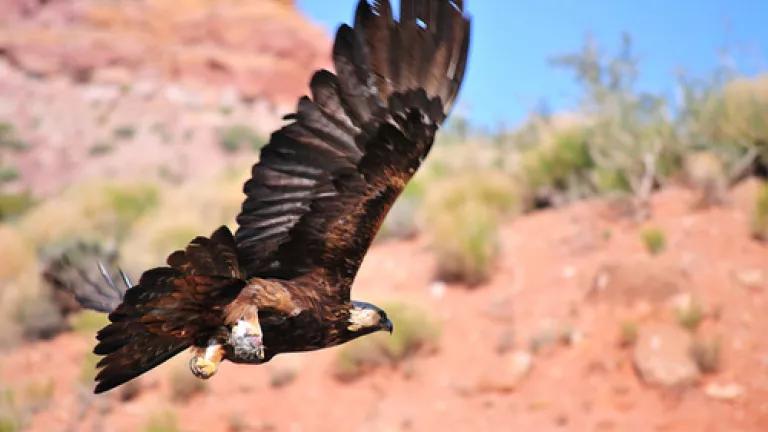To Minimize Wind Power's Impact on Birds & Bats, The Dept. of Energy Can Use AWWI As A Model

The Department of Energy's new budget came out on Tuesday. And with it, came the prospect of continued funding--either through a line item or through its discretionary budget--for the study of wind power/wildlife conflict. That is, for the study of interactions between wind turbines, birds and other kinds of wildlife that sometimes lead to fatalities and other impacts.
The American Wind Wildlife Institute, a unique collaboration among scientists, industry and environmental groups, can serve as a model for the US Department of Energy as it studies the interactions between wind turbines and wildlife, such as golden eagles like this one and other raptors. (photo credit: Dave Taylor via Flickr)
With enough wind power to juice up up to 12 million homes likely to come online between now and 2021,and even more expected between 2022 and 2030, thanks to the EPA's Clean Power Plan to cut carbon pollution from the nation's electric sector, this funding couldn't be more opportune or more necessary. In fact, there's no better time than now to figure out why, how, and where these conflicts happen. And there's no better time than now to figure out what we can do to prevent, minimize and mitigate them. That's why, should this funding continue as anticipated, NRDC is eager to make sure it's used in the most impactful way possible. We look forward to working on these priorities with the DOE, the wind power industry, and other environmental groups. And we hope the American Wind Wildlife Institute, a unique collaboration among environmentalists, scientists, and the wind power industry, can serve as a model for DOE in this area.
Before we start this discussion of wind power/wildlife conflict and how the DOE can best use funding to address the problem, let's be aware that the largest threat to birds, bats, and other wildlife is climate change, not wind power.
So dangerous is climate change, in fact, that it endangers or threatens more than half of American bird species, a 2014 Audubon study found. By cutting carbon pollution from the electric sector, then, wind power can help protect wildlife. We need a massive wind power build out to effectively stop global warming. Still, species and landscapes can sometimes be put at risk by large-scale wind power development. (Here, NRDC has pioneered and endorses a "Smart from the Start" siting policy that promotes renewable energy development in pre-screened areas with few wildlife/landscape conflicts while precluding development in critical conservation areas.)
As the DOE likely pursues this field of study and action, AWWI--the only group of its kind that currently works to both understand and then solve the environmental problems wind power development sometimes presents--can serve as a guide, a partner, and a model.
The organization and the work that it does is well worth trumpeting, not only for what it's accomplished so far but also for the model of collaboration that it represents. (Full disclosure: I became AWWI's board chair last month. Hooray!)
The organization can guide the DOE by doing what it does best: focusing on the science and technology of wildlife-wind turbine interactions--by "Identifying the key issues," Executive Director Abby Arnold explains. "What do we know about the science? What do we need to know? And what do we need to do?"
Founded about six years ago, AWWI has already worked with the American Wind Energy Association, the wind industry trade group, to develop voluntary operating protocols that can cut bat deaths by as much as 30 percent. (Seventeen of AWEA's member companies, representing 60 percent of the country's installed wind power capacity, have already adopted the protocol. Impressive, no?) With the Nature Conservancy, AWWI has helped develop the Landscape Assessment Tool, a GIS platform that maps wind resources and species distribution across the country. It helps developers understand where best to site their projects to avoid and minimize wildlife interference. (The tool can also cut the cost of wind power, by helping make the siting and regulatory process smoother and less litigious.)
AWWI partners with conservation scientists, "with an eye towards producing independent, credible results that are publishable in peer-reviewed journals," Arnold explains. To date, the organization has published papers addressing questions such as the relative risks wind turbines pose to small birds, and the efficacy of UV lighting in deterring raptor-turbine collisions. "Our job is to develop the science that other people"--developers and regulators in particular--"can use," Arnold says.
The group is piloting the American Wind Wildlife Information Center, a searchable database and library that will include peer-reviewed wind-wildlife research, published articles and reports, and publicly available but un-published reports prepared for wind energy facilities, all in one online location. (The resource will go live later this year.) Unlike other tools, it will include anonymous, confidential data from private developers and operators, meaning the database will offer a much more granular picture for scientists and developers to work from. And, AWWI is active in testing new technologies and operating methods. "If we're going to build enough wind to get serious about climate," Arnold says, "we need more sophisticated solutions."
These are solutions the DOE can help fund, using AWWI as a model for its efforts: industry, science, advocacy, and now government working together to make sure we don't destroy the natural world in order to save it.

